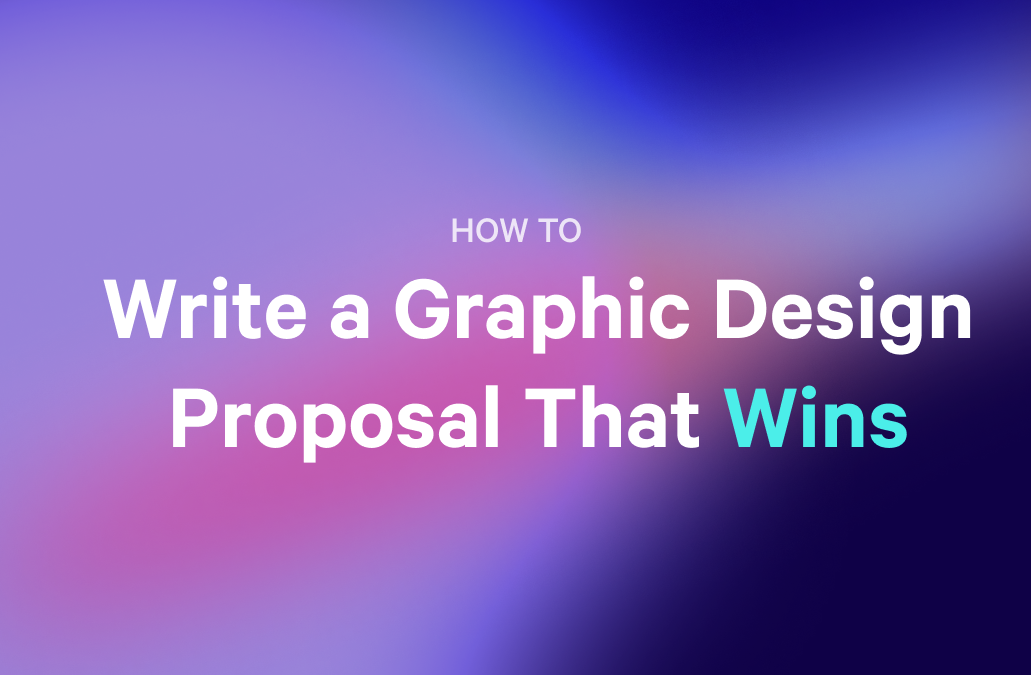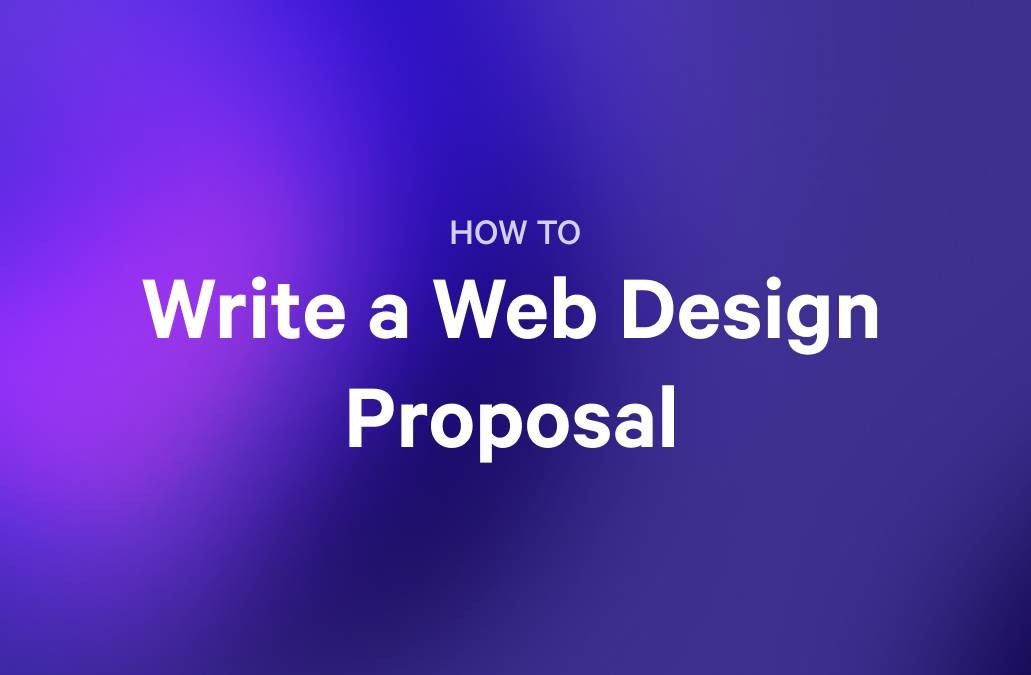The user experience has never been more important, and this has created a sector as competitive as it is lucrative. This is why, today, a great UX design proposal is so crucial.
A UX design proposal is more than just a routine plan. It's about creating and communicating your vision, one that paints a vivid picture of success in your client's mind’s eye. When this is done correctly, it can help you win more projects or user experience design consulting engagements.
This article will help you do just that.
We'll show you how to write a UX design proposal that communicates your ideas with clarity, serving to engage and excite your prospective clients. In short, it is a proposal that will separate you from the pack.
Key takeaways:
- A UX design proposal is a strategic document that outlines the process, deliverables, and vision for a user experience project.
- Understanding the client's needs, defining user personas, and setting clear objectives are crucial steps in writing a UX design proposal.
- The proposal should detail the design process, timeline, budget, and showcase the designer's expertise.
- A compelling call to action (CTA) is essential in a UX design proposal to prompt the client to respond.
- Using a UX design proposal template can help ensure all critical elements are included and presented professionally.
What is a UX design proposal?
A UX design proposal outlines the strategy, process, and deliverables for a user experience design project—a bridge connecting your customer's needs with what you can offer creatively.
The core of all effective sales methodologies is to get to the bottom of customer problems and find solutions. The proposal is your chance to show how well you understand users and how you will create intuitive and enjoyable designs.
A good UX design proposal must be compelling, balancing creativity with practicality, to show how your design meets both the company's goals and the user's needs. It's about being bold and explaining your ideas clearly so everyone understands your vision and its potential impact.
Are you more of a visual learner? The Qwilr UX Design Proposal template gives you a better idea of exactly what I mean here.
Steps to write a UX design proposal: Key elements to include
Writing a successful design proposal is about creating a solution tailor-made for your client's needs. In the following steps, we'll show you the key points- what you should include and why - when writing a sales proposal that hits all the right notes.
1. Understand the client's needs
Before you start writing your UX design proposal, you must really understand your client's business and their needs. You can do this through a free UX consultation (if you offer that) or through research. You want to understand your stakeholders and their goals thoroughly. You also want to ensure that you understand their business. Who is buying their products? What challenges are they facing?
Understanding these points demonstrates your attention to detail and investment in their project, positioning you as more of a partner than just a ‘gun for hire’ which builds customer trust. This first step is also a way to qualify leads that come to your inbound; it allows you to make sure your services are a good fit for the client's needs and projects before you begin to write a lengthy proposal.
2. Define user personas
This is where you get to know the people who will use your design when the project is live. In this step, you draw a detailed picture of your client's targeted audience. It's about more than just knowing their age or where they live. It's about understanding what they do, what they need, what drives them, and what they want to achieve.
As much as possible, this should be driven by real user data. Spending time gathering or reviewing behavioral data at this juncture can help you craft a better, more thorough proposal. Only when you truly know your customers can you properly serve them. These personas will guide your design decisions, helping you determine which design features or workflows are most important and appeal most to your client's target audience.
3. Set clear objectives
Clear goals ensure every stakeholder understands and agrees on the project's direction.
First of all, you need to be specific. Broad goals like 'improve the user experience' are a good start, but you need to define the goals precisely. What does 'better user experience' mean for this project? Could it mean a faster website, increased buyer engagement, an easier-to-use web app with fewer bugs, or a more intuitive front-end interface? These specific goals will guide your design decisions and proposed solutions.
You should also be able to measure your goals. Saying you want to 'increase user engagement' is good, but how will you measure success? You could try to reduce the bounce rate by 10% or increase the number of sign-ups by 20%. If you have goals that you can measure, not only will it make your objectives clearer, but you can also track how well the designs you implement are performing against the targets.
It's also essential that you align with the client's business goals. If the client wants to increase sales online, your design goals should help achieve this more significant objective. This shows the client that your design is a strategic part of their business growth.
4. Outline the design process
By outlining your design process, you give the client a clear map of how you'll turn your ideas into a great design.
First, give an overview of the different stages in your design process. This could include:
- Initial research
- Ideation
- Making basic layouts (wireframes)
- Creating prototypes
- Testing these with users
- Actual implementation of the design
Explain the extent of their involvement at each stage and show how each step leads to the next: how the research will shape your ideas, which will then feed into the creation of your wireframes and so on. This shows that your process is considered and cohesive.
5. Detail the timeline and budget
When writing a web design proposal for improved UX, you must be clear and upfront with your client about time and money.
Let's start with the timeline. It's crucial to divide the project into different phases and say how long each will take. This can include the initial research, user testing, and the final steps to complete the project. Give an estimated time to completion for each of these stages.
This detailed timeline will help the client understand how the project will advance and when you will need their involvement or approvals. Set realistic phases, so you don't put yourself under unnecessary pressure before you've even started!
For the budget, you need to lay out the costs for the project clearly. Break down the costs into different parts, such as research, creating visual styles, initial designs, revisions, and packaging up files for handoff to the developers. This allows the client to see where their money is going and what is included in the price.
The goal is to be transparent and realistic when stating the timeline and budget. You're showing the client that you have diligently planned the project's schedule and costing.
6. Showcase your expertise
This is your personal showcase, where you can highlight your skills and the great work you've done so far. Select some of your best work related to the client's needs and tell the story behind it.
Talk about the challenges you faced, the solutions you found, and, of course, what a great job you did!
Relaying the information like this, rather than in a cold list of achievements, brings them to life and, again, helps paint that picture for your prospective client.
You may find it helpful to read our guide on how to write a case study.
It's also essential to show you're current with a UX design scene. Maybe you've recently attended workshops or know the latest UX design software. This shows the client that you're constantly learning and improving your skills.
When presenting your expertise, be confident but not boastful. Admittedly, this can feel like a fine line to skate!
7. Include a call to action
A call to action (CTA) is essential to your proposal. Now you’ve told them what you can do, what do you want them to do?
Aim for a clear, concise, and engaging CTA, and then make it easy for your prospect to take action.
This might mean that you provide your contact details, include an accept or eSignature button, propose a time for a meeting, or suggest a simple next step they can take. The easier you make it for them to respond, the more likely they are to do so.
Example of a UX design proposal template
Writing UX design proposals can be tricky, even though we've already outlined the sections you must include. A UX design proposal template is a great shortcut to ensure you don’t forget critical elements of your pitch, saving a ton of time and providing a professional, visually impressive showcase.
We've put together a UX Design proposal template to get you started with all of this in mind. It’s ready for you to tweak as you see fit, and you won’t need your coding skills to do it, either!
Here is what the design proposal template includes:
- Executive Summary: This short introduction grabs the client's attention and gives an overview of your plan. This part should be simple, engaging, and to the point.
- Understanding the Client's Needs: This section lays the foundation for how your design solutions will meet the client's specific needs, showing the lengths you have gone to understand them and the project fully.
- Your Priorities: This part focuses on the most important to the client. It's about tailoring your design to what the client values most and ensuring your proposal is relevant and targeted.
- 12-Month Goals: In this section, you outline the goals for the following year. It's about setting clear, achievable goals that align with the client's long-term vision.
- Our Approach: This is where you explain how you want to approach the project. Describe your process from the initial research phase to the final steps. This section should give a good impression of your unique approach to UX design.
- Service Overview: Here, you describe the services you offer. It's more than just a list – an opportunity to explain how each service helps achieve the client's objectives.
- About Us (Achievements and Team): This section is your chance to showcase your team's skills and achievements. It builds confidence by showing your qualifications, your experience, and your successful projects to date.
- Investment Required: It is essential to be transparent about the costs. Break down the investments required for the project so that they are easy to understand.
- Contact Us: Close with an inviting call to action. Provide your contact information and encourage the client to get in touch to discuss more or ask questions.
You can also try our ai proposal generator software.
Takeaway
If you're ready to adopt a clear, creative, and user-centered approach to UX design proposals, follow the steps above, and you’ll be on the right path!
We hope this article has demystified the process for you, but if you’d like a little more help, check out our UX design proposal template. It ensures your proposal reflects the sleek, professional work you are offering and lets you spend more of your time doing just that -- designing great user experience instead of drafting additional proposals.
About the author

Brendan Connaughton|Head of Growth Marketing
Brendan heads up growth marketing and demand generation at Qwilr, overseeing performance marketing, SEO, and lifecycle initiatives. Brendan has been instrumental in developing go-to-market functions for a number of high-growth startups and challenger brands.
Frequently asked questions
The best format for a UX design proposal document is easy to understand and user-focussed. It should start with a summary, show that you have a good understanding of what the client needs, set out clear goals, explain how you plan to achieve those goals, and include details of your services and budget, as well as an invitation for the client to get in touch.
A UX design proposal is a strategic document that outlines the process, deliverables, and vision for a user experience project. It connects customer needs with your creative offerings, and is a chance to show your understanding of users and how you will create intuitive and enjoyable designs.
Key elements include understanding the client's needs, defining user personas, setting clear objectives, outlining the design process, detailing the timeline and budget, showcasing your expertise, and including a compelling call to action.
Showcase your expertise by highlighting your skills and past work related to the client's needs. Discuss the challenges you faced, the solutions you found, and the success of the project. Show that you're current with the UX design scene, such as attending workshops or knowing the latest design software.
A call to action (CTA) is essential to prompt the client to respond. It could be providing your contact details, including an accept or eSignature button, proposing a time for a meeting, or suggesting a simple next step they can take.
A UX design proposal template is a preformatted document that helps you ensure all critical elements of your pitch are included. It saves time and provides a professional, visually impressive showcase. It includes sections like executive summary, understanding the client's needs, your priorities, 12-month goals, your approach, service overview, about us, investment required, and contact us.


